Business Economics Report
VerifiedAdded on 2020/02/05
|8
|2372
|53
Report
AI Summary
This report assesses the impact of low interest rates on the British economy over the past seven years. It examines the effects on investment, consumption, savings, and pensions, noting that while low rates stimulated investment and consumption, they also led to increased debt and reduced savings. The report further analyzes the consequences of this policy, including the inflation of house prices and the potential for future economic instability. Finally, it discusses the expected actions of the Bank of England regarding future interest rate adjustments.
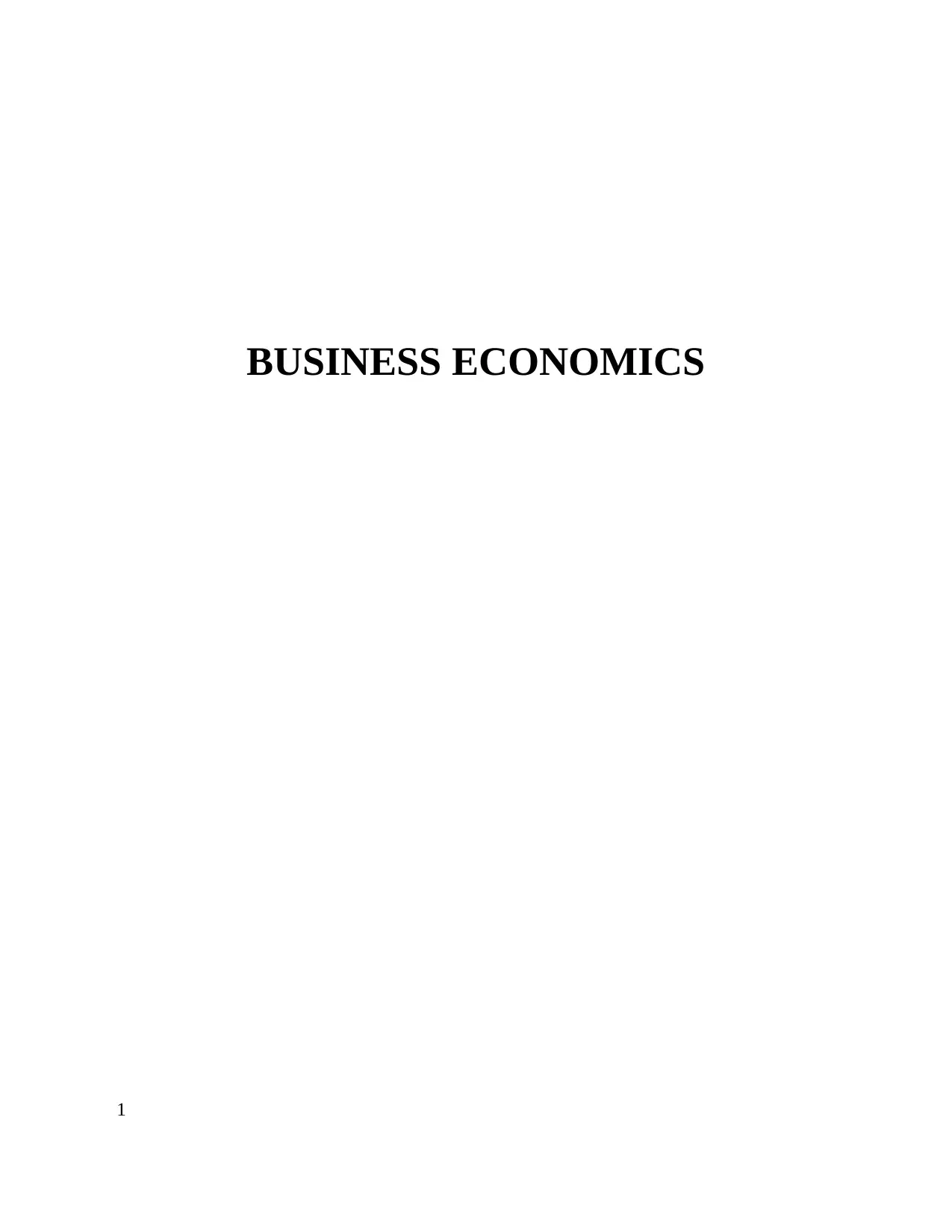
BUSINESS ECONOMICS
1
1
Paraphrase This Document
Need a fresh take? Get an instant paraphrase of this document with our AI Paraphraser
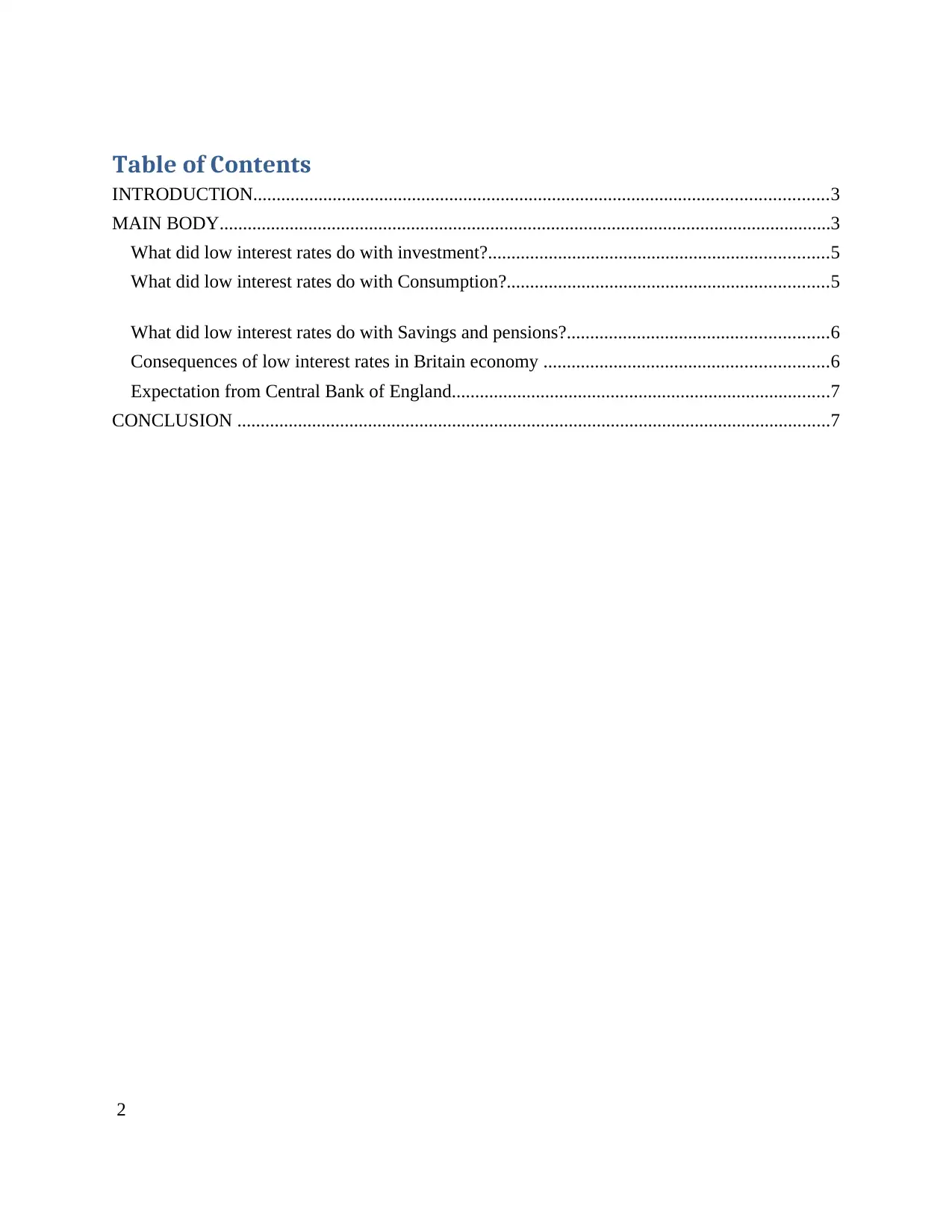
Table of Contents
INTRODUCTION...........................................................................................................................3
MAIN BODY...................................................................................................................................3
What did low interest rates do with investment?.........................................................................5
What did low interest rates do with Consumption?.....................................................................5
What did low interest rates do with Savings and pensions?........................................................6
Consequences of low interest rates in Britain economy .............................................................6
Expectation from Central Bank of England.................................................................................7
CONCLUSION ...............................................................................................................................7
2
INTRODUCTION...........................................................................................................................3
MAIN BODY...................................................................................................................................3
What did low interest rates do with investment?.........................................................................5
What did low interest rates do with Consumption?.....................................................................5
What did low interest rates do with Savings and pensions?........................................................6
Consequences of low interest rates in Britain economy .............................................................6
Expectation from Central Bank of England.................................................................................7
CONCLUSION ...............................................................................................................................7
2
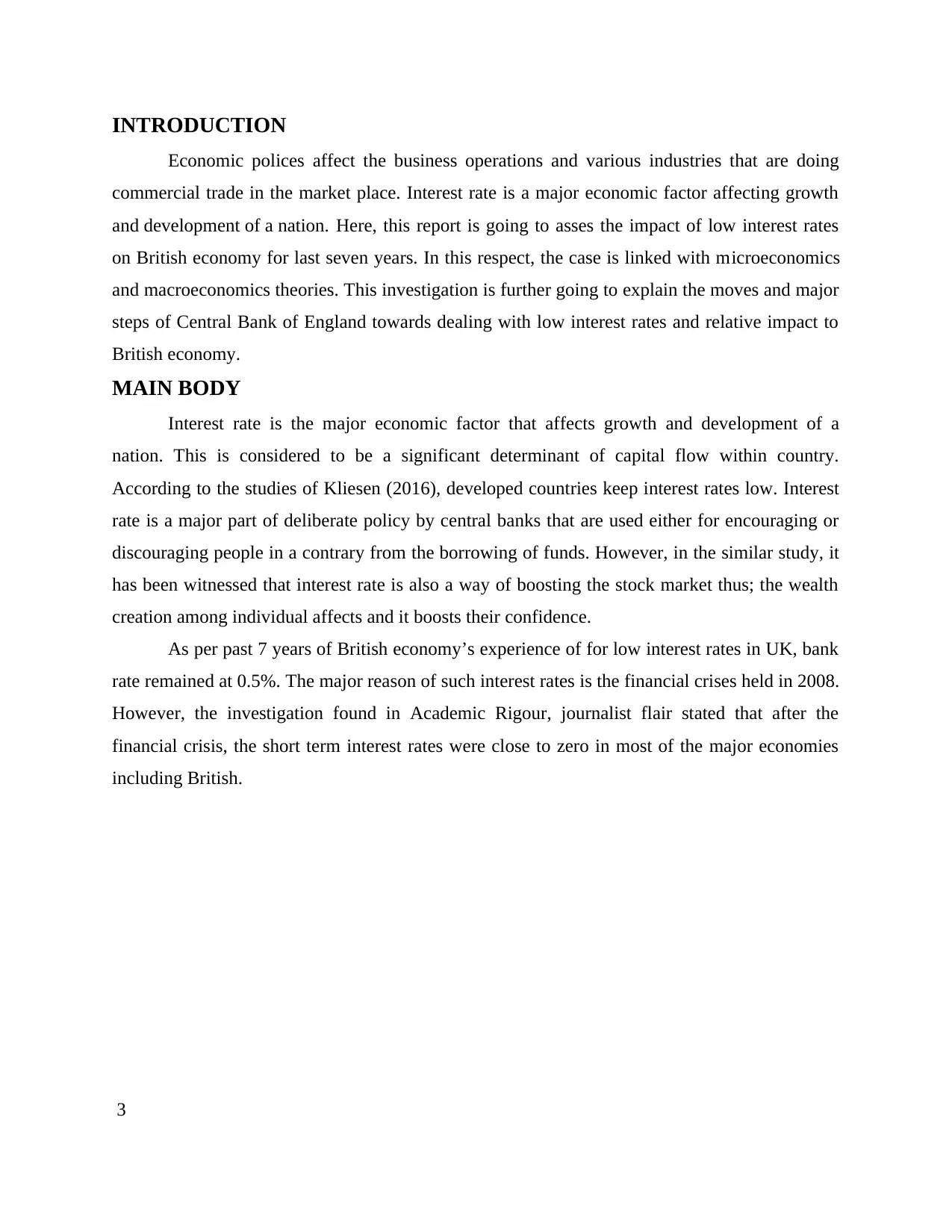
INTRODUCTION
Economic polices affect the business operations and various industries that are doing
commercial trade in the market place. Interest rate is a major economic factor affecting growth
and development of a nation. Here, this report is going to asses the impact of low interest rates
on British economy for last seven years. In this respect, the case is linked with microeconomics
and macroeconomics theories. This investigation is further going to explain the moves and major
steps of Central Bank of England towards dealing with low interest rates and relative impact to
British economy.
MAIN BODY
Interest rate is the major economic factor that affects growth and development of a
nation. This is considered to be a significant determinant of capital flow within country.
According to the studies of Kliesen (2016), developed countries keep interest rates low. Interest
rate is a major part of deliberate policy by central banks that are used either for encouraging or
discouraging people in a contrary from the borrowing of funds. However, in the similar study, it
has been witnessed that interest rate is also a way of boosting the stock market thus; the wealth
creation among individual affects and it boosts their confidence.
As per past 7 years of British economy’s experience of for low interest rates in UK, bank
rate remained at 0.5%. The major reason of such interest rates is the financial crises held in 2008.
However, the investigation found in Academic Rigour, journalist flair stated that after the
financial crisis, the short term interest rates were close to zero in most of the major economies
including British.
3
Economic polices affect the business operations and various industries that are doing
commercial trade in the market place. Interest rate is a major economic factor affecting growth
and development of a nation. Here, this report is going to asses the impact of low interest rates
on British economy for last seven years. In this respect, the case is linked with microeconomics
and macroeconomics theories. This investigation is further going to explain the moves and major
steps of Central Bank of England towards dealing with low interest rates and relative impact to
British economy.
MAIN BODY
Interest rate is the major economic factor that affects growth and development of a
nation. This is considered to be a significant determinant of capital flow within country.
According to the studies of Kliesen (2016), developed countries keep interest rates low. Interest
rate is a major part of deliberate policy by central banks that are used either for encouraging or
discouraging people in a contrary from the borrowing of funds. However, in the similar study, it
has been witnessed that interest rate is also a way of boosting the stock market thus; the wealth
creation among individual affects and it boosts their confidence.
As per past 7 years of British economy’s experience of for low interest rates in UK, bank
rate remained at 0.5%. The major reason of such interest rates is the financial crises held in 2008.
However, the investigation found in Academic Rigour, journalist flair stated that after the
financial crisis, the short term interest rates were close to zero in most of the major economies
including British.
3
⊘ This is a preview!⊘
Do you want full access?
Subscribe today to unlock all pages.

Trusted by 1+ million students worldwide
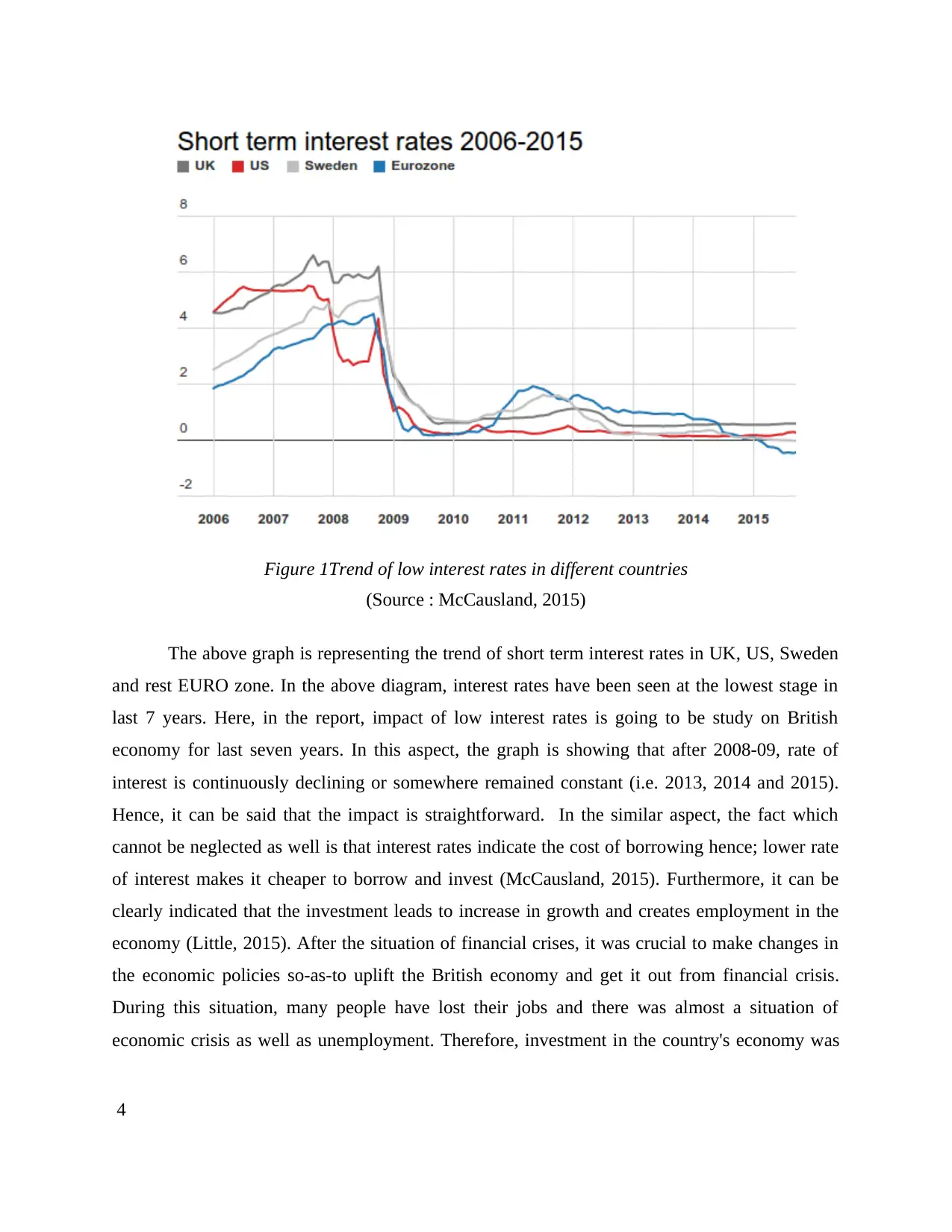
The above graph is representing the trend of short term interest rates in UK, US, Sweden
and rest EURO zone. In the above diagram, interest rates have been seen at the lowest stage in
last 7 years. Here, in the report, impact of low interest rates is going to be study on British
economy for last seven years. In this aspect, the graph is showing that after 2008-09, rate of
interest is continuously declining or somewhere remained constant (i.e. 2013, 2014 and 2015).
Hence, it can be said that the impact is straightforward. In the similar aspect, the fact which
cannot be neglected as well is that interest rates indicate the cost of borrowing hence; lower rate
of interest makes it cheaper to borrow and invest (McCausland, 2015). Furthermore, it can be
clearly indicated that the investment leads to increase in growth and creates employment in the
economy (Little, 2015). After the situation of financial crises, it was crucial to make changes in
the economic policies so-as-to uplift the British economy and get it out from financial crisis.
During this situation, many people have lost their jobs and there was almost a situation of
economic crisis as well as unemployment. Therefore, investment in the country's economy was
4
Figure 1Trend of low interest rates in different countries
(Source : McCausland, 2015)
and rest EURO zone. In the above diagram, interest rates have been seen at the lowest stage in
last 7 years. Here, in the report, impact of low interest rates is going to be study on British
economy for last seven years. In this aspect, the graph is showing that after 2008-09, rate of
interest is continuously declining or somewhere remained constant (i.e. 2013, 2014 and 2015).
Hence, it can be said that the impact is straightforward. In the similar aspect, the fact which
cannot be neglected as well is that interest rates indicate the cost of borrowing hence; lower rate
of interest makes it cheaper to borrow and invest (McCausland, 2015). Furthermore, it can be
clearly indicated that the investment leads to increase in growth and creates employment in the
economy (Little, 2015). After the situation of financial crises, it was crucial to make changes in
the economic policies so-as-to uplift the British economy and get it out from financial crisis.
During this situation, many people have lost their jobs and there was almost a situation of
economic crisis as well as unemployment. Therefore, investment in the country's economy was
4
Figure 1Trend of low interest rates in different countries
(Source : McCausland, 2015)
Paraphrase This Document
Need a fresh take? Get an instant paraphrase of this document with our AI Paraphraser
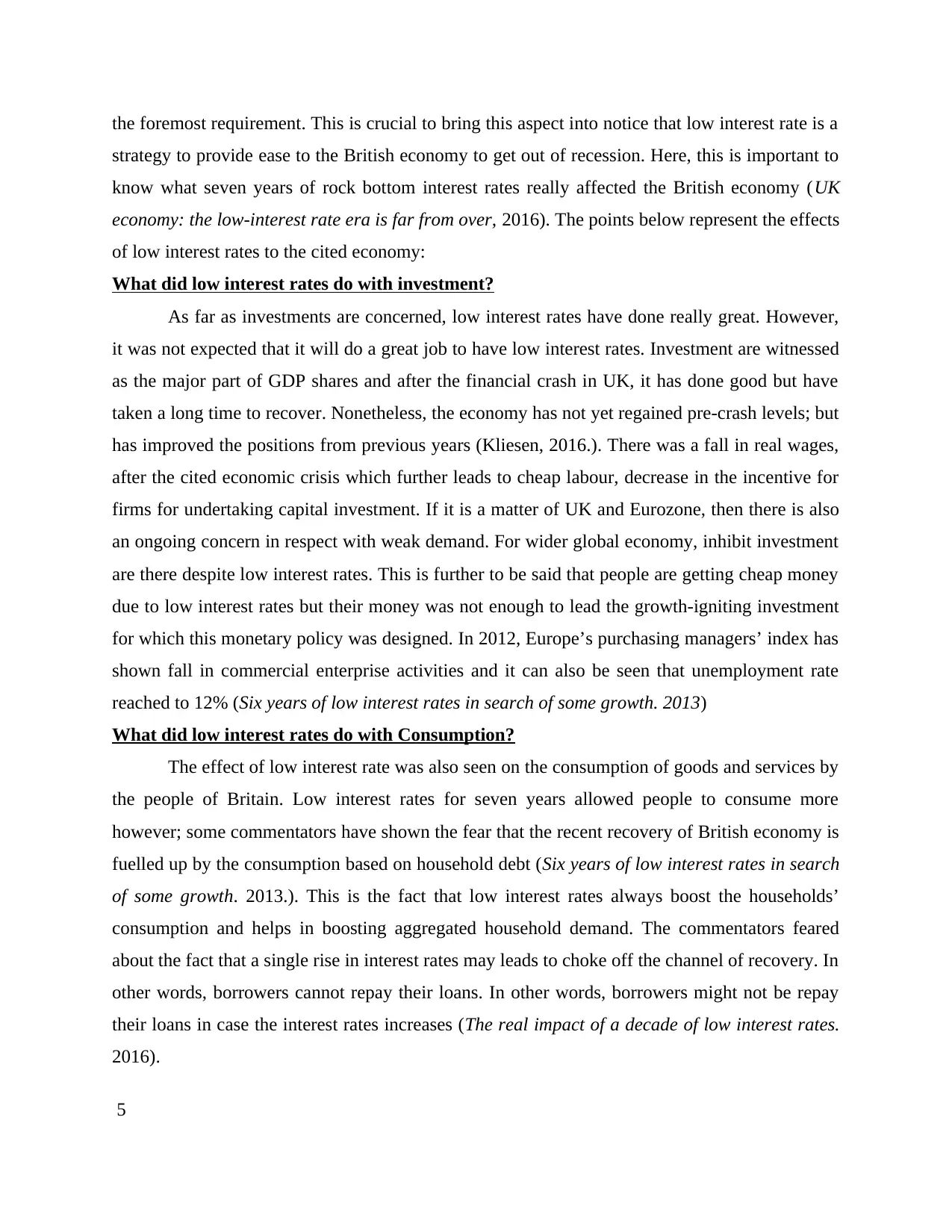
the foremost requirement. This is crucial to bring this aspect into notice that low interest rate is a
strategy to provide ease to the British economy to get out of recession. Here, this is important to
know what seven years of rock bottom interest rates really affected the British economy (UK
economy: the low-interest rate era is far from over, 2016). The points below represent the effects
of low interest rates to the cited economy:
What did low interest rates do with investment?
As far as investments are concerned, low interest rates have done really great. However,
it was not expected that it will do a great job to have low interest rates. Investment are witnessed
as the major part of GDP shares and after the financial crash in UK, it has done good but have
taken a long time to recover. Nonetheless, the economy has not yet regained pre-crash levels; but
has improved the positions from previous years (Kliesen, 2016.). There was a fall in real wages,
after the cited economic crisis which further leads to cheap labour, decrease in the incentive for
firms for undertaking capital investment. If it is a matter of UK and Eurozone, then there is also
an ongoing concern in respect with weak demand. For wider global economy, inhibit investment
are there despite low interest rates. This is further to be said that people are getting cheap money
due to low interest rates but their money was not enough to lead the growth-igniting investment
for which this monetary policy was designed. In 2012, Europe’s purchasing managers’ index has
shown fall in commercial enterprise activities and it can also be seen that unemployment rate
reached to 12% (Six years of low interest rates in search of some growth. 2013)
What did low interest rates do with Consumption?
The effect of low interest rate was also seen on the consumption of goods and services by
the people of Britain. Low interest rates for seven years allowed people to consume more
however; some commentators have shown the fear that the recent recovery of British economy is
fuelled up by the consumption based on household debt (Six years of low interest rates in search
of some growth. 2013.). This is the fact that low interest rates always boost the households’
consumption and helps in boosting aggregated household demand. The commentators feared
about the fact that a single rise in interest rates may leads to choke off the channel of recovery. In
other words, borrowers cannot repay their loans. In other words, borrowers might not be repay
their loans in case the interest rates increases (The real impact of a decade of low interest rates.
2016).
5
strategy to provide ease to the British economy to get out of recession. Here, this is important to
know what seven years of rock bottom interest rates really affected the British economy (UK
economy: the low-interest rate era is far from over, 2016). The points below represent the effects
of low interest rates to the cited economy:
What did low interest rates do with investment?
As far as investments are concerned, low interest rates have done really great. However,
it was not expected that it will do a great job to have low interest rates. Investment are witnessed
as the major part of GDP shares and after the financial crash in UK, it has done good but have
taken a long time to recover. Nonetheless, the economy has not yet regained pre-crash levels; but
has improved the positions from previous years (Kliesen, 2016.). There was a fall in real wages,
after the cited economic crisis which further leads to cheap labour, decrease in the incentive for
firms for undertaking capital investment. If it is a matter of UK and Eurozone, then there is also
an ongoing concern in respect with weak demand. For wider global economy, inhibit investment
are there despite low interest rates. This is further to be said that people are getting cheap money
due to low interest rates but their money was not enough to lead the growth-igniting investment
for which this monetary policy was designed. In 2012, Europe’s purchasing managers’ index has
shown fall in commercial enterprise activities and it can also be seen that unemployment rate
reached to 12% (Six years of low interest rates in search of some growth. 2013)
What did low interest rates do with Consumption?
The effect of low interest rate was also seen on the consumption of goods and services by
the people of Britain. Low interest rates for seven years allowed people to consume more
however; some commentators have shown the fear that the recent recovery of British economy is
fuelled up by the consumption based on household debt (Six years of low interest rates in search
of some growth. 2013.). This is the fact that low interest rates always boost the households’
consumption and helps in boosting aggregated household demand. The commentators feared
about the fact that a single rise in interest rates may leads to choke off the channel of recovery. In
other words, borrowers cannot repay their loans. In other words, borrowers might not be repay
their loans in case the interest rates increases (The real impact of a decade of low interest rates.
2016).
5
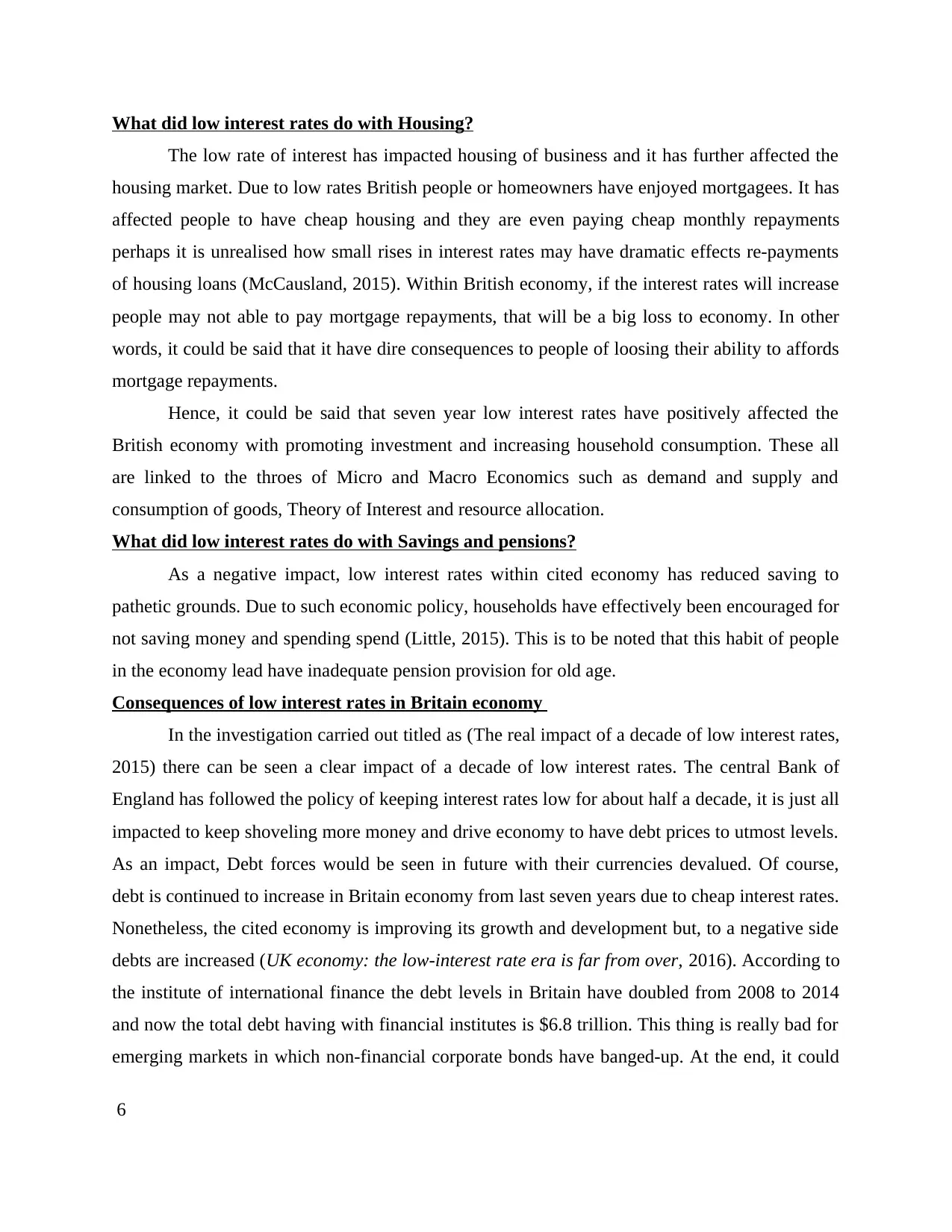
What did low interest rates do with Housing?
The low rate of interest has impacted housing of business and it has further affected the
housing market. Due to low rates British people or homeowners have enjoyed mortgagees. It has
affected people to have cheap housing and they are even paying cheap monthly repayments
perhaps it is unrealised how small rises in interest rates may have dramatic effects re-payments
of housing loans (McCausland, 2015). Within British economy, if the interest rates will increase
people may not able to pay mortgage repayments, that will be a big loss to economy. In other
words, it could be said that it have dire consequences to people of loosing their ability to affords
mortgage repayments.
Hence, it could be said that seven year low interest rates have positively affected the
British economy with promoting investment and increasing household consumption. These all
are linked to the throes of Micro and Macro Economics such as demand and supply and
consumption of goods, Theory of Interest and resource allocation.
What did low interest rates do with Savings and pensions?
As a negative impact, low interest rates within cited economy has reduced saving to
pathetic grounds. Due to such economic policy, households have effectively been encouraged for
not saving money and spending spend (Little, 2015). This is to be noted that this habit of people
in the economy lead have inadequate pension provision for old age.
Consequences of low interest rates in Britain economy
In the investigation carried out titled as (The real impact of a decade of low interest rates,
2015) there can be seen a clear impact of a decade of low interest rates. The central Bank of
England has followed the policy of keeping interest rates low for about half a decade, it is just all
impacted to keep shoveling more money and drive economy to have debt prices to utmost levels.
As an impact, Debt forces would be seen in future with their currencies devalued. Of course,
debt is continued to increase in Britain economy from last seven years due to cheap interest rates.
Nonetheless, the cited economy is improving its growth and development but, to a negative side
debts are increased (UK economy: the low-interest rate era is far from over, 2016). According to
the institute of international finance the debt levels in Britain have doubled from 2008 to 2014
and now the total debt having with financial institutes is $6.8 trillion. This thing is really bad for
emerging markets in which non-financial corporate bonds have banged-up. At the end, it could
6
The low rate of interest has impacted housing of business and it has further affected the
housing market. Due to low rates British people or homeowners have enjoyed mortgagees. It has
affected people to have cheap housing and they are even paying cheap monthly repayments
perhaps it is unrealised how small rises in interest rates may have dramatic effects re-payments
of housing loans (McCausland, 2015). Within British economy, if the interest rates will increase
people may not able to pay mortgage repayments, that will be a big loss to economy. In other
words, it could be said that it have dire consequences to people of loosing their ability to affords
mortgage repayments.
Hence, it could be said that seven year low interest rates have positively affected the
British economy with promoting investment and increasing household consumption. These all
are linked to the throes of Micro and Macro Economics such as demand and supply and
consumption of goods, Theory of Interest and resource allocation.
What did low interest rates do with Savings and pensions?
As a negative impact, low interest rates within cited economy has reduced saving to
pathetic grounds. Due to such economic policy, households have effectively been encouraged for
not saving money and spending spend (Little, 2015). This is to be noted that this habit of people
in the economy lead have inadequate pension provision for old age.
Consequences of low interest rates in Britain economy
In the investigation carried out titled as (The real impact of a decade of low interest rates,
2015) there can be seen a clear impact of a decade of low interest rates. The central Bank of
England has followed the policy of keeping interest rates low for about half a decade, it is just all
impacted to keep shoveling more money and drive economy to have debt prices to utmost levels.
As an impact, Debt forces would be seen in future with their currencies devalued. Of course,
debt is continued to increase in Britain economy from last seven years due to cheap interest rates.
Nonetheless, the cited economy is improving its growth and development but, to a negative side
debts are increased (UK economy: the low-interest rate era is far from over, 2016). According to
the institute of international finance the debt levels in Britain have doubled from 2008 to 2014
and now the total debt having with financial institutes is $6.8 trillion. This thing is really bad for
emerging markets in which non-financial corporate bonds have banged-up. At the end, it could
6
⊘ This is a preview!⊘
Do you want full access?
Subscribe today to unlock all pages.

Trusted by 1+ million students worldwide
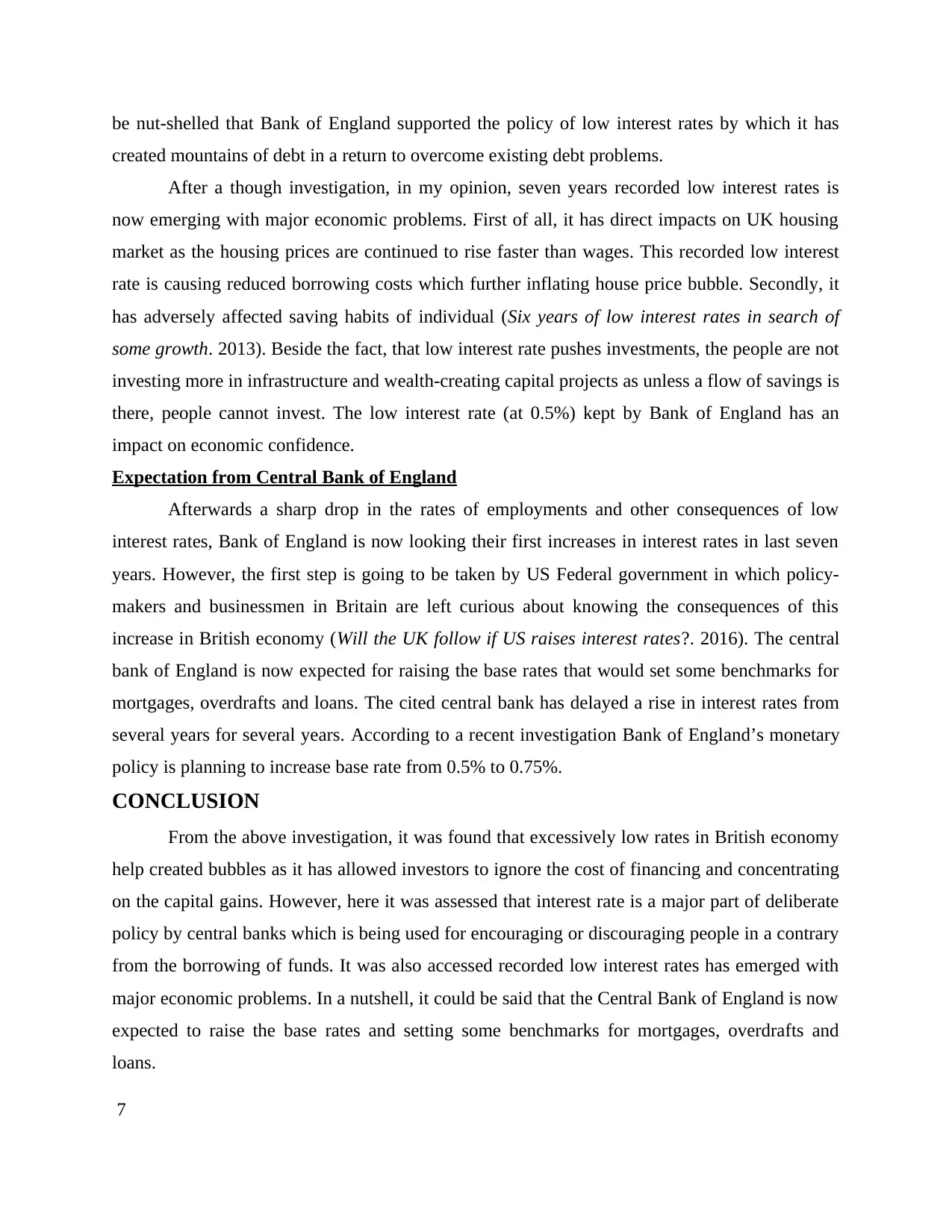
be nut-shelled that Bank of England supported the policy of low interest rates by which it has
created mountains of debt in a return to overcome existing debt problems.
After a though investigation, in my opinion, seven years recorded low interest rates is
now emerging with major economic problems. First of all, it has direct impacts on UK housing
market as the housing prices are continued to rise faster than wages. This recorded low interest
rate is causing reduced borrowing costs which further inflating house price bubble. Secondly, it
has adversely affected saving habits of individual (Six years of low interest rates in search of
some growth. 2013). Beside the fact, that low interest rate pushes investments, the people are not
investing more in infrastructure and wealth-creating capital projects as unless a flow of savings is
there, people cannot invest. The low interest rate (at 0.5%) kept by Bank of England has an
impact on economic confidence.
Expectation from Central Bank of England
Afterwards a sharp drop in the rates of employments and other consequences of low
interest rates, Bank of England is now looking their first increases in interest rates in last seven
years. However, the first step is going to be taken by US Federal government in which policy-
makers and businessmen in Britain are left curious about knowing the consequences of this
increase in British economy (Will the UK follow if US raises interest rates?. 2016). The central
bank of England is now expected for raising the base rates that would set some benchmarks for
mortgages, overdrafts and loans. The cited central bank has delayed a rise in interest rates from
several years for several years. According to a recent investigation Bank of England’s monetary
policy is planning to increase base rate from 0.5% to 0.75%.
CONCLUSION
From the above investigation, it was found that excessively low rates in British economy
help created bubbles as it has allowed investors to ignore the cost of financing and concentrating
on the capital gains. However, here it was assessed that interest rate is a major part of deliberate
policy by central banks which is being used for encouraging or discouraging people in a contrary
from the borrowing of funds. It was also accessed recorded low interest rates has emerged with
major economic problems. In a nutshell, it could be said that the Central Bank of England is now
expected to raise the base rates and setting some benchmarks for mortgages, overdrafts and
loans.
7
created mountains of debt in a return to overcome existing debt problems.
After a though investigation, in my opinion, seven years recorded low interest rates is
now emerging with major economic problems. First of all, it has direct impacts on UK housing
market as the housing prices are continued to rise faster than wages. This recorded low interest
rate is causing reduced borrowing costs which further inflating house price bubble. Secondly, it
has adversely affected saving habits of individual (Six years of low interest rates in search of
some growth. 2013). Beside the fact, that low interest rate pushes investments, the people are not
investing more in infrastructure and wealth-creating capital projects as unless a flow of savings is
there, people cannot invest. The low interest rate (at 0.5%) kept by Bank of England has an
impact on economic confidence.
Expectation from Central Bank of England
Afterwards a sharp drop in the rates of employments and other consequences of low
interest rates, Bank of England is now looking their first increases in interest rates in last seven
years. However, the first step is going to be taken by US Federal government in which policy-
makers and businessmen in Britain are left curious about knowing the consequences of this
increase in British economy (Will the UK follow if US raises interest rates?. 2016). The central
bank of England is now expected for raising the base rates that would set some benchmarks for
mortgages, overdrafts and loans. The cited central bank has delayed a rise in interest rates from
several years for several years. According to a recent investigation Bank of England’s monetary
policy is planning to increase base rate from 0.5% to 0.75%.
CONCLUSION
From the above investigation, it was found that excessively low rates in British economy
help created bubbles as it has allowed investors to ignore the cost of financing and concentrating
on the capital gains. However, here it was assessed that interest rate is a major part of deliberate
policy by central banks which is being used for encouraging or discouraging people in a contrary
from the borrowing of funds. It was also accessed recorded low interest rates has emerged with
major economic problems. In a nutshell, it could be said that the Central Bank of England is now
expected to raise the base rates and setting some benchmarks for mortgages, overdrafts and
loans.
7
Paraphrase This Document
Need a fresh take? Get an instant paraphrase of this document with our AI Paraphraser
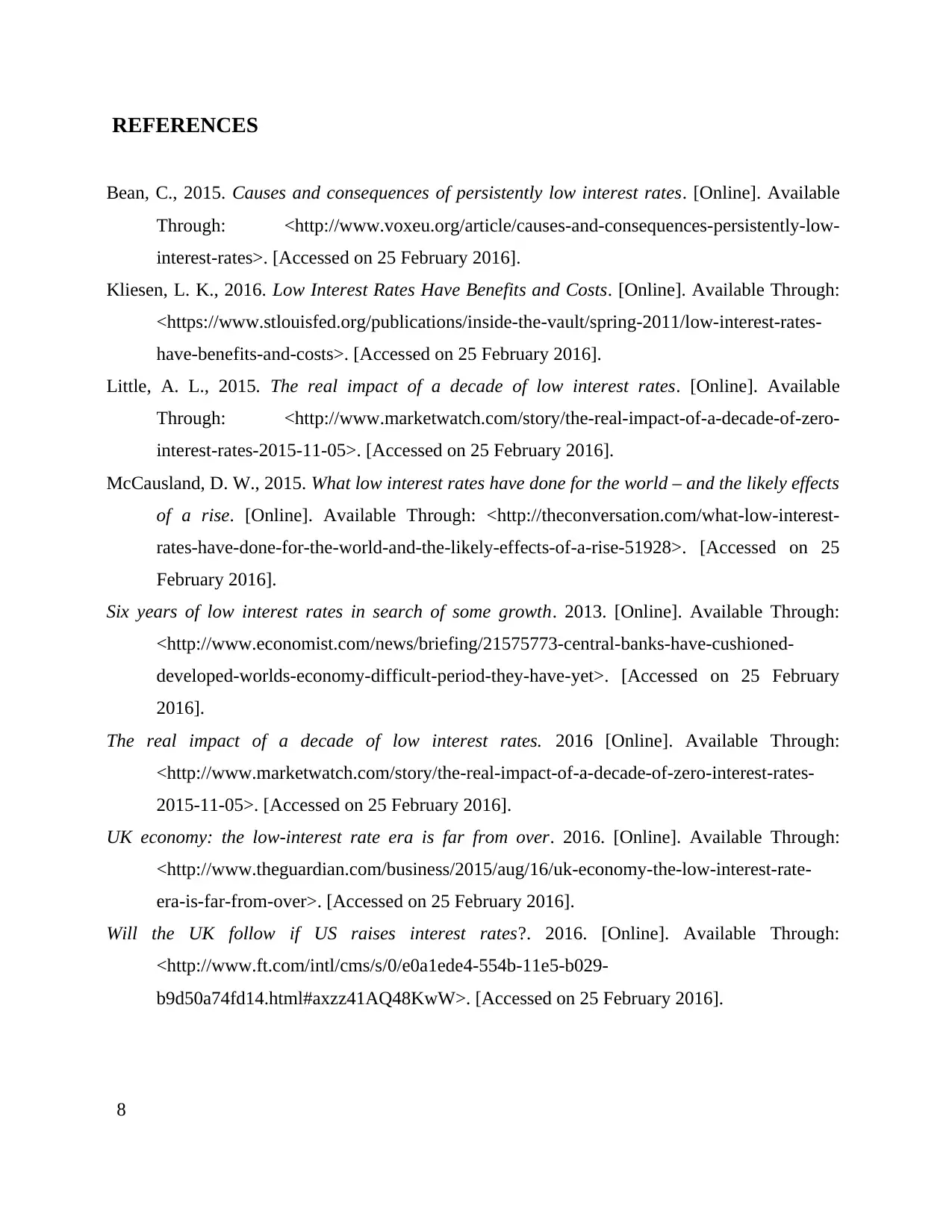
REFERENCES
Bean, C., 2015. Causes and consequences of persistently low interest rates. [Online]. Available
Through: <http://www.voxeu.org/article/causes-and-consequences-persistently-low-
interest-rates>. [Accessed on 25 February 2016].
Kliesen, L. K., 2016. Low Interest Rates Have Benefits and Costs. [Online]. Available Through:
<https://www.stlouisfed.org/publications/inside-the-vault/spring-2011/low-interest-rates-
have-benefits-and-costs>. [Accessed on 25 February 2016].
Little, A. L., 2015. The real impact of a decade of low interest rates. [Online]. Available
Through: <http://www.marketwatch.com/story/the-real-impact-of-a-decade-of-zero-
interest-rates-2015-11-05>. [Accessed on 25 February 2016].
McCausland, D. W., 2015. What low interest rates have done for the world – and the likely effects
of a rise. [Online]. Available Through: <http://theconversation.com/what-low-interest-
rates-have-done-for-the-world-and-the-likely-effects-of-a-rise-51928>. [Accessed on 25
February 2016].
Six years of low interest rates in search of some growth. 2013. [Online]. Available Through:
<http://www.economist.com/news/briefing/21575773-central-banks-have-cushioned-
developed-worlds-economy-difficult-period-they-have-yet>. [Accessed on 25 February
2016].
The real impact of a decade of low interest rates. 2016 [Online]. Available Through:
<http://www.marketwatch.com/story/the-real-impact-of-a-decade-of-zero-interest-rates-
2015-11-05>. [Accessed on 25 February 2016].
UK economy: the low-interest rate era is far from over. 2016. [Online]. Available Through:
<http://www.theguardian.com/business/2015/aug/16/uk-economy-the-low-interest-rate-
era-is-far-from-over>. [Accessed on 25 February 2016].
Will the UK follow if US raises interest rates?. 2016. [Online]. Available Through:
<http://www.ft.com/intl/cms/s/0/e0a1ede4-554b-11e5-b029-
b9d50a74fd14.html#axzz41AQ48KwW>. [Accessed on 25 February 2016].
8
Bean, C., 2015. Causes and consequences of persistently low interest rates. [Online]. Available
Through: <http://www.voxeu.org/article/causes-and-consequences-persistently-low-
interest-rates>. [Accessed on 25 February 2016].
Kliesen, L. K., 2016. Low Interest Rates Have Benefits and Costs. [Online]. Available Through:
<https://www.stlouisfed.org/publications/inside-the-vault/spring-2011/low-interest-rates-
have-benefits-and-costs>. [Accessed on 25 February 2016].
Little, A. L., 2015. The real impact of a decade of low interest rates. [Online]. Available
Through: <http://www.marketwatch.com/story/the-real-impact-of-a-decade-of-zero-
interest-rates-2015-11-05>. [Accessed on 25 February 2016].
McCausland, D. W., 2015. What low interest rates have done for the world – and the likely effects
of a rise. [Online]. Available Through: <http://theconversation.com/what-low-interest-
rates-have-done-for-the-world-and-the-likely-effects-of-a-rise-51928>. [Accessed on 25
February 2016].
Six years of low interest rates in search of some growth. 2013. [Online]. Available Through:
<http://www.economist.com/news/briefing/21575773-central-banks-have-cushioned-
developed-worlds-economy-difficult-period-they-have-yet>. [Accessed on 25 February
2016].
The real impact of a decade of low interest rates. 2016 [Online]. Available Through:
<http://www.marketwatch.com/story/the-real-impact-of-a-decade-of-zero-interest-rates-
2015-11-05>. [Accessed on 25 February 2016].
UK economy: the low-interest rate era is far from over. 2016. [Online]. Available Through:
<http://www.theguardian.com/business/2015/aug/16/uk-economy-the-low-interest-rate-
era-is-far-from-over>. [Accessed on 25 February 2016].
Will the UK follow if US raises interest rates?. 2016. [Online]. Available Through:
<http://www.ft.com/intl/cms/s/0/e0a1ede4-554b-11e5-b029-
b9d50a74fd14.html#axzz41AQ48KwW>. [Accessed on 25 February 2016].
8
1 out of 8
Related Documents
Your All-in-One AI-Powered Toolkit for Academic Success.
+13062052269
info@desklib.com
Available 24*7 on WhatsApp / Email
![[object Object]](/_next/static/media/star-bottom.7253800d.svg)
Unlock your academic potential
Copyright © 2020–2025 A2Z Services. All Rights Reserved. Developed and managed by ZUCOL.





